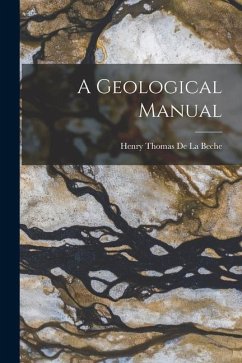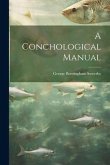Henry Thomas De La Beche
A Geological Manual
29,99 €
inkl. MwSt.
Versandfertig in über 4 Wochen

15 °P sammeln
Andere Kunden interessierten sich auch für
![A Description of the Island of St. Michael: Comprising an Account of Its Geological Structure A Description of the Island of St. Michael: Comprising an Account of Its Geological Structure]() John White WebsterA Description of the Island of St. Michael: Comprising an Account of Its Geological Structure23,99 €
John White WebsterA Description of the Island of St. Michael: Comprising an Account of Its Geological Structure23,99 €![Spons' Mechanics' Own Book: A Manual for Handicraftsmen and Amateurs Spons' Mechanics' Own Book: A Manual for Handicraftsmen and Amateurs]() Edward SponSpons' Mechanics' Own Book: A Manual for Handicraftsmen and Amateurs34,99 €
Edward SponSpons' Mechanics' Own Book: A Manual for Handicraftsmen and Amateurs34,99 €![Elementary Course in Mechanical Drawing for Manual Training and Technical Schools ...: With Chapters On Machine Sketching and the Blue-Printing Proces Elementary Course in Mechanical Drawing for Manual Training and Technical Schools ...: With Chapters On Machine Sketching and the Blue-Printing Proces]() AnonymousElementary Course in Mechanical Drawing for Manual Training and Technical Schools ...: With Chapters On Machine Sketching and the Blue-Printing Proces19,99 €
AnonymousElementary Course in Mechanical Drawing for Manual Training and Technical Schools ...: With Chapters On Machine Sketching and the Blue-Printing Proces19,99 €![A Conchological Manual A Conchological Manual]() George Brettingham SowerbyA Conchological Manual19,99 €
George Brettingham SowerbyA Conchological Manual19,99 €![A Manual for Use at Funerals: Consisting of Scripture Readings, Poems, and Prose Selections From Various Sources A Manual for Use at Funerals: Consisting of Scripture Readings, Poems, and Prose Selections From Various Sources]() Charles Jason StaplesA Manual for Use at Funerals: Consisting of Scripture Readings, Poems, and Prose Selections From Various Sources20,99 €
Charles Jason StaplesA Manual for Use at Funerals: Consisting of Scripture Readings, Poems, and Prose Selections From Various Sources20,99 €![A Manual of Composition and Rhetoric: A Text-Book for Schools and Colleges A Manual of Composition and Rhetoric: A Text-Book for Schools and Colleges]() John Seely HartA Manual of Composition and Rhetoric: A Text-Book for Schools and Colleges27,99 €
John Seely HartA Manual of Composition and Rhetoric: A Text-Book for Schools and Colleges27,99 €![Mechanical Drawing: A Manual for Teachers and Students Mechanical Drawing: A Manual for Teachers and Students]() Anson Kent CrossMechanical Drawing: A Manual for Teachers and Students22,99 €
Anson Kent CrossMechanical Drawing: A Manual for Teachers and Students22,99 €-
-
-
Produktdetails
- Verlag: Creative Media Partners, LLC
- Seitenzahl: 550
- Erscheinungstermin: 27. Oktober 2022
- Englisch
- Abmessung: 234mm x 156mm x 28mm
- Gewicht: 762g
- ISBN-13: 9781017367102
- ISBN-10: 1017367108
- Artikelnr.: 67113121
Hinweis: Dieser Artikel kann nur an eine deutsche Lieferadresse ausgeliefert werden.
- Herstellerkennzeichnung
- Libri GmbH
- Europaallee 1
- 36244 Bad Hersfeld
- gpsr@libri.de
Preface
Section I: 1. Figure of the Earth
2. Density of the Earth
3. Superficial distribution of land and water
4. Saltness and specific gravity of the sea
5. Temperature of the Earth
6. Temperature of springs
7. Temperature of the sea and of lakes
8. Temperature of the atmosphere
9. Valleys
10. Changes on the surface of the globe
11. Classification of rocks
Section II: 12. Degradation of land
13. Rivers
14. Glaciers
15. Delivery of detritus into the sea
16. Action of the sea on coasts
17. Shingle beaches
18. Sandy beaches
19. Tides
20. Currents
21. Transporting power of tides
22. Transporting power of currents
23. Active volcanos
24. Extinct volcanos
25. Mineral volcanic products
26. Volcanic dykes, etc.
27. Earthquakes
28. Hurricanes
29. Gaseous exhalations
30. Deposits from springs
31. Naphtha and asphaltum springs
32. Coral reefs and islands
33. Submarine forests
34. Raised beaches and masses of shells
35. Organic remains of the modern group
Section III: 36. Erratic blocks and gravel
37. Ossiferous caverns and osseous breccia
Section IV: 38. Supracretaceous (tertiary) group
39. Volcanic action during the supracretaceous period
Section V: 40. Cretaceous group (chalk and green sand)
41. Wealden rocks
Section VI: 42. Oolitic group
Section VII: 43. Red sandstone group
Section VIII: 44. Carboniferous group
Section IX: 45. Grauwacke group
Section X: 46. Inferior stratified or non-fossiliferous rocks
Section XI: 47. Unstratified rocks
Section XII: 48. On the mineralogical differences in contemporaneous rocks
49. On the elevation of mountains
50. On the occurrence of metals in rocks
Section XIII: 51. Organic remains in the supracretaceous blue marl of the south of France
52. Organic remains in the supracretaceous rocks of Bordeaux and Dax
53. Gosau fossils
54. Organic remains of the cretaceous group, of the Wealden rocks of England, of the Oolitic group, of the red or variegated marl, of the muschelkalk, of the red or variegated sandstone, of the Zechstone, of the coal measures, of the carboniferous limestone, of the grauwacke group
Appendix
Index.
Section I: 1. Figure of the Earth
2. Density of the Earth
3. Superficial distribution of land and water
4. Saltness and specific gravity of the sea
5. Temperature of the Earth
6. Temperature of springs
7. Temperature of the sea and of lakes
8. Temperature of the atmosphere
9. Valleys
10. Changes on the surface of the globe
11. Classification of rocks
Section II: 12. Degradation of land
13. Rivers
14. Glaciers
15. Delivery of detritus into the sea
16. Action of the sea on coasts
17. Shingle beaches
18. Sandy beaches
19. Tides
20. Currents
21. Transporting power of tides
22. Transporting power of currents
23. Active volcanos
24. Extinct volcanos
25. Mineral volcanic products
26. Volcanic dykes, etc.
27. Earthquakes
28. Hurricanes
29. Gaseous exhalations
30. Deposits from springs
31. Naphtha and asphaltum springs
32. Coral reefs and islands
33. Submarine forests
34. Raised beaches and masses of shells
35. Organic remains of the modern group
Section III: 36. Erratic blocks and gravel
37. Ossiferous caverns and osseous breccia
Section IV: 38. Supracretaceous (tertiary) group
39. Volcanic action during the supracretaceous period
Section V: 40. Cretaceous group (chalk and green sand)
41. Wealden rocks
Section VI: 42. Oolitic group
Section VII: 43. Red sandstone group
Section VIII: 44. Carboniferous group
Section IX: 45. Grauwacke group
Section X: 46. Inferior stratified or non-fossiliferous rocks
Section XI: 47. Unstratified rocks
Section XII: 48. On the mineralogical differences in contemporaneous rocks
49. On the elevation of mountains
50. On the occurrence of metals in rocks
Section XIII: 51. Organic remains in the supracretaceous blue marl of the south of France
52. Organic remains in the supracretaceous rocks of Bordeaux and Dax
53. Gosau fossils
54. Organic remains of the cretaceous group, of the Wealden rocks of England, of the Oolitic group, of the red or variegated marl, of the muschelkalk, of the red or variegated sandstone, of the Zechstone, of the coal measures, of the carboniferous limestone, of the grauwacke group
Appendix
Index.
Preface
Section I: 1. Figure of the Earth
2. Density of the Earth
3. Superficial distribution of land and water
4. Saltness and specific gravity of the sea
5. Temperature of the Earth
6. Temperature of springs
7. Temperature of the sea and of lakes
8. Temperature of the atmosphere
9. Valleys
10. Changes on the surface of the globe
11. Classification of rocks
Section II: 12. Degradation of land
13. Rivers
14. Glaciers
15. Delivery of detritus into the sea
16. Action of the sea on coasts
17. Shingle beaches
18. Sandy beaches
19. Tides
20. Currents
21. Transporting power of tides
22. Transporting power of currents
23. Active volcanos
24. Extinct volcanos
25. Mineral volcanic products
26. Volcanic dykes, etc.
27. Earthquakes
28. Hurricanes
29. Gaseous exhalations
30. Deposits from springs
31. Naphtha and asphaltum springs
32. Coral reefs and islands
33. Submarine forests
34. Raised beaches and masses of shells
35. Organic remains of the modern group
Section III: 36. Erratic blocks and gravel
37. Ossiferous caverns and osseous breccia
Section IV: 38. Supracretaceous (tertiary) group
39. Volcanic action during the supracretaceous period
Section V: 40. Cretaceous group (chalk and green sand)
41. Wealden rocks
Section VI: 42. Oolitic group
Section VII: 43. Red sandstone group
Section VIII: 44. Carboniferous group
Section IX: 45. Grauwacke group
Section X: 46. Inferior stratified or non-fossiliferous rocks
Section XI: 47. Unstratified rocks
Section XII: 48. On the mineralogical differences in contemporaneous rocks
49. On the elevation of mountains
50. On the occurrence of metals in rocks
Section XIII: 51. Organic remains in the supracretaceous blue marl of the south of France
52. Organic remains in the supracretaceous rocks of Bordeaux and Dax
53. Gosau fossils
54. Organic remains of the cretaceous group, of the Wealden rocks of England, of the Oolitic group, of the red or variegated marl, of the muschelkalk, of the red or variegated sandstone, of the Zechstone, of the coal measures, of the carboniferous limestone, of the grauwacke group
Appendix
Index.
Section I: 1. Figure of the Earth
2. Density of the Earth
3. Superficial distribution of land and water
4. Saltness and specific gravity of the sea
5. Temperature of the Earth
6. Temperature of springs
7. Temperature of the sea and of lakes
8. Temperature of the atmosphere
9. Valleys
10. Changes on the surface of the globe
11. Classification of rocks
Section II: 12. Degradation of land
13. Rivers
14. Glaciers
15. Delivery of detritus into the sea
16. Action of the sea on coasts
17. Shingle beaches
18. Sandy beaches
19. Tides
20. Currents
21. Transporting power of tides
22. Transporting power of currents
23. Active volcanos
24. Extinct volcanos
25. Mineral volcanic products
26. Volcanic dykes, etc.
27. Earthquakes
28. Hurricanes
29. Gaseous exhalations
30. Deposits from springs
31. Naphtha and asphaltum springs
32. Coral reefs and islands
33. Submarine forests
34. Raised beaches and masses of shells
35. Organic remains of the modern group
Section III: 36. Erratic blocks and gravel
37. Ossiferous caverns and osseous breccia
Section IV: 38. Supracretaceous (tertiary) group
39. Volcanic action during the supracretaceous period
Section V: 40. Cretaceous group (chalk and green sand)
41. Wealden rocks
Section VI: 42. Oolitic group
Section VII: 43. Red sandstone group
Section VIII: 44. Carboniferous group
Section IX: 45. Grauwacke group
Section X: 46. Inferior stratified or non-fossiliferous rocks
Section XI: 47. Unstratified rocks
Section XII: 48. On the mineralogical differences in contemporaneous rocks
49. On the elevation of mountains
50. On the occurrence of metals in rocks
Section XIII: 51. Organic remains in the supracretaceous blue marl of the south of France
52. Organic remains in the supracretaceous rocks of Bordeaux and Dax
53. Gosau fossils
54. Organic remains of the cretaceous group, of the Wealden rocks of England, of the Oolitic group, of the red or variegated marl, of the muschelkalk, of the red or variegated sandstone, of the Zechstone, of the coal measures, of the carboniferous limestone, of the grauwacke group
Appendix
Index.







